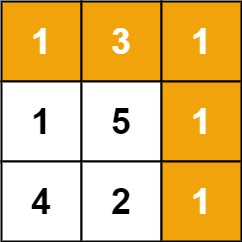Leetcode: Minimum Path Sum
Problem Description
Problem definition is taken from leetcode.
Given a m x n grid filled with non-negative numbers, find a path from top left to bottom right, which minimizes the sum of all numbers along its path.
Note: You can only move either down or right at any point in time.
For Unique Paths 1 problem visit Unique Paths 1
Example 1

Input: grid = [[1,3,1],[1,5,1],[4,2,1]]
Output: 7
Explanation: Because the path 1 → 3 → 1 → 1 → 1 minimizes the sum.
Example 2
Input: grid = [[1,2,3],[4,5,6]]
Output: 12
Solution
Solution is similar to Unique Paths 1.
However, instead of summing number of cells in a path, cost of the cells in a path are computed. A separate grid is needed to make computations. Starting from target cell, Given a cell, neighbour (left or up) values are updated if not previously computed or there is a cheaper path available.
Copy of the grid is needed. Thus space complexity is O(mXn) Time complexity is O(mxn).
class Solution:
def minPathSum(self, grid: List[List[int]]) -> int:
m = len(grid)
n = len(grid[0])
if m==1 or n==1:
return sum(sum(row)for row in grid)
newGrid = [[None for j in range(n)] for i in range(m)]
newGrid[m-1][n-1]=grid[m-1][n-1]
for i in range(m-1, -1, -1):
for j in range(n-1, -1, -1):
self.step(grid, newGrid, i, j)
return min(newGrid[0][1], newGrid[1][0])+grid[0][0]
def step(self, grid, newGrid, i,j):
cost = newGrid[i][j] or grid[i][j]
if j>0 and (newGrid[i][j-1] is None or newGrid[i][j-1]>cost+grid[i][j-1]):
newGrid[i][j-1]=cost+grid[i][j-1]
if i>0 and (newGrid[i-1][j] is None or newGrid[i-1][j]>cost+grid[i-1][j]):
newGrid[i-1][j]=cost+grid[i-1][j]
